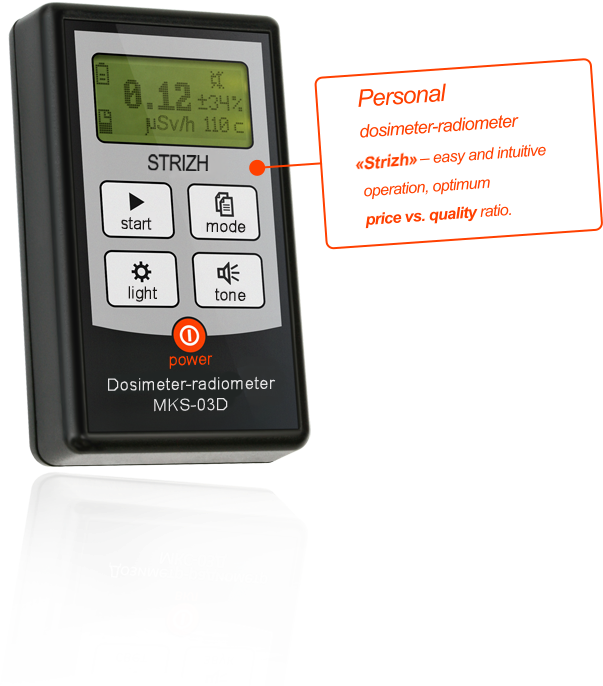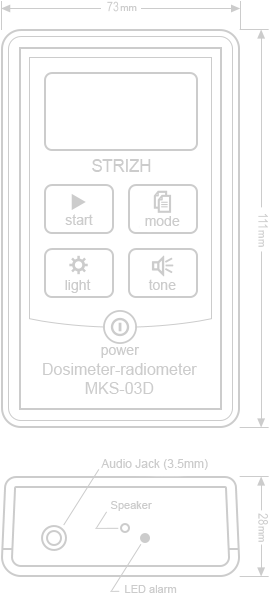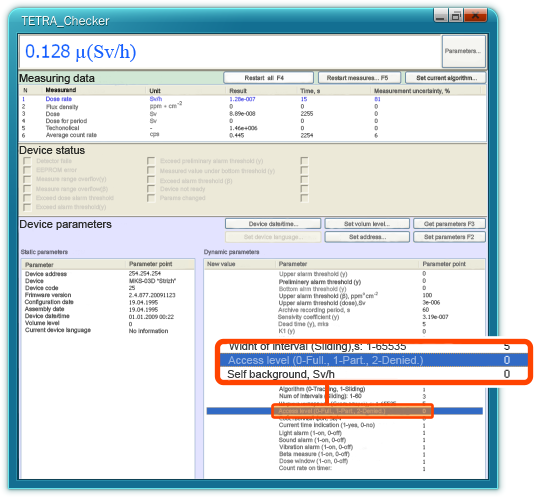About «Strizh»
MKS-03D «Strizh» dosimeter-radiometer
Development of a dosimeter-radiometer MKS-03D «Strizh» was completed in summer 2009. Prior to this design «Strizh» has been tested with several types of displays, processors, cases and design solutions. The final version of the dosimeter-radiometer included the best structure parts for this time — modern detector, as well as the processor and display (which appeared in the pricelists of their manufacturers only in 2008).
Our goal has been achieved – we created a modern «intelligent» dosimeter-radiometer, which has many unique qualities:
- we applied a thin graphical display, which shows the information with maximum clarity. The display supports multiple fonts and can display any of the original special characters;
- detector Beta-1, which is embedded in the dosimeter-radiometer, has an exceptional sensitivity and detectable energy range, compared to the GMS-20 and GMS-21 counters used in similar devices. These advantages are especially important to those users who use (or intend to use) the MKS-03D «Strizh» for domestic purposes;
- the dosimeter’s measuring capabilities range from the natural background level up to 0.1 Sv/h! Additional tests confirmed dose tolerance of «Strizh» to up to 10 Sv/h!;
- MKS-03D «Strizh» detects two radiation types – beta and gamma;
- the dosimeter-radiometer generates sound signals to indicate the following events:
- one or several particles detection;
- exceeding the regulation threshold – dose, dose rate or flux density;
- the battery is getting low;
- the key is pressed;
- convenient functions of light and dynamic (vibration) threshold alarm;
- clock, timer and alarm clock modes;
- continuous monitoring of performance and residual capacity of batteries;
- display backlight.
Detailed specifications are available on the manufacturer's website.
Information shown on the
MKS-03D «Strizh» display
Graphical display, embedded in MKS-03D «Strizh» solved the main issue of the dosimeters of previous generations – limited comprehension. Due to insufficient «portrayal» abilities none of the previously developed dosimeters could indicate such an important parameter as measurement uncertainty (shown in percentage of the indicated value).
Some users call uncertainty an error, inaccuracy, but this is wrong even despite they may look alike. International standard CEI/IEC 61526:2005 gives the following definition: «The uncertainty of measurement is parameter, associated with the result of a measurement that characterizes the dispersion of the values that could reasonably be attributed to the measurand.»
Explanation. If you performed a measurement of a dose rate and received the result of 0,2 µSv/h with an uncertainty of 50%, this indicates that the result of a repeated measurement may be in range from 0,1 to 0,3 µSv/h. The range is huge, and when searching for areas of the possible radiation contamination it is simply inacceptable.
Uncertainty is one of the most important indicators of quality of the measurement. Taking into consideration the known quantity of uncertainty, user can decide whether it is necessary to continue to measure until the acceptable uncertainty is reached, or to abort the measurement, or to make a series of additional measurements.
Measuring until the acceptable (regulated) uncertainty is one of the requirements of various measuring methods.
Information shown on the display of MKS-03D «Strizh» is the most comprehensive and contains the following elements:
- measurement result, shown in big and clearly visible numbers;
- measurement uncertainty;
- measurement duration;
- units of measurements with necessary fraction prefixes (µ – micro, m – milli, k – kilo), and a set of special symbols, including:
- residual battery charge symbol;
- regulation threshold exceeding symbol;
- sound alarm status symbol.
Additionally to the possibility to «see all the necessary», user can disable «everything excessive» in his dosimeter-radiometer. A few words about that.
Depending on user’s needs, MKS-03D can operate in different modes and provide a number of simultaneously working windows:
- measurement of the gamma radiation dose;
- operator dose measurement;
- measurement of the beta radiation flux density;
- clock;
- alarm clock, timer.
Modes are displayed in different windows and can be switched cyclically with the specific button. To stay focused on necessary details, it is possible for an operator to close the windows that are not in use.
Additional functions of MKS-03D «Strizh»
This small part of the description is for gourmets.
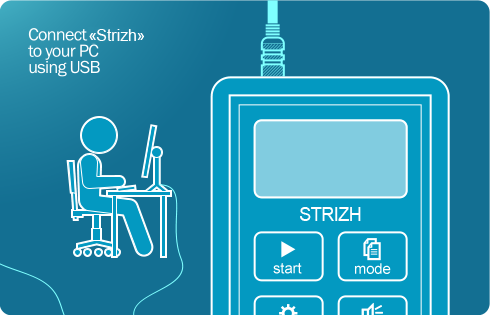
Many of features of MKS-03D «Strizh» become accessible with the PC connection. The dosimeter-radiometer can be connected to the PC through USB-port. From the computer one can monitor the status of MKS-03D «Strizh», manage and adjust the measurement process. It uses a set of free software, that allows to work remotely with the dosimeter.
Provided PC-compatibility (TETRA_Checker program) allowed to manage the following advanced features of the dosimeter-radiometer:
- feature of disabling certain operation modes of the dosimeter-radiometer by setting a ban on their display;
- managing and control of the level of access to particular function of the dosimeter-radiometer. If necessary, user experience of operating the dosimeter-radiometer can be limited up to the ban on off power(Table access levels).
Table access levels
- 012
Menu settings
- Alarm thresholds
- Threshold (γ)
- Threshold (β)
- Threshold (доза)
- Coefficients
- Sensivity coefficient (γ)
- Dead time (γ)
- К1 (γ), К2 (γ), К3 (γ)
- Sensivity coefficient (β)
- Dead time (β)
- К1 (β), К2 (β), К3 (β)
- Settings
- Dose window
- Clock window
- Alarm settings
- Archive recording period
- Clear archive
- Display off timeout, min
- Algorithm
- Sliding
- Tracking
- Help
- Producer
- Software version
Menu settings
- Dose rate window
- Threshold (γ)
- Sliding
- Tracking
- Flux density window
- Threshold (β)
- Sliding
- Tracking
- Dose window
- Threshold dose
- Archive recording period
- Clock window
Power off MKS-03D
Thanks to its potential to work with the external control devices, MKS-03D «Strizh» can be a part of higher-level systems. For instance, complex of features embedded in MKS-03D «Strizh» allows to engineer a personal dosimetric control system of a company on its base.
The dosimeter-radiometer has an internal archive of the operator’s dose measurements. Periodic entries are made automatically into the archive. PC synchronization of the archive entries is made through the «TETRA_Reporter» software.
Amazingly, but all these features have fit into a pocket-sized case.
Dosimeter-radiometer setting, calibration and control operations can be performed form PC at a safe distance from the radiation sources.
Descriptions of the exchange protocol and information registries of the dosimeter-radiometer are opened for use. Free test software is supplied.
Domestic use of the MKS-03D «Strizh»
Measurements of gamma radiation dose rate for domestic purposes are usually done on radiation survey of:
- land;
- building structures and materials;
- living and working quarters;
- equipment, vehicles, or machinery;
- harvested food (berries, herbs, mushrooms...).
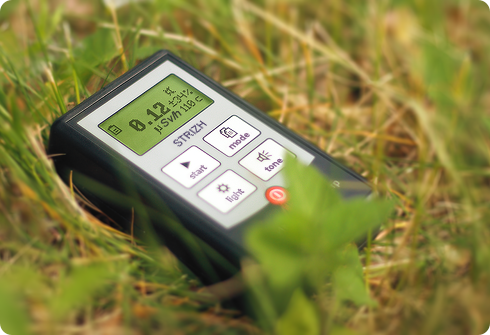
Living and working quarters survey
Places of people’s long-term stay must have a minimum background radiation. Quarters survey helps to figure out which spots are the preferred locations for a workplace, as well as places for rest and sleep. If we talk about the house, where we live, rest, and sleep, then it is absolutely not a bad idea – along with «managing energy flows according to Feng Shui» – to check the level of gamma background radiation. Most likely, you will not find any anomaly, but will be able to locate a spot with the minimum of gamma background.
How exactly important is this?
The severity of the resulting human exposure and the likelihood of tissue damage depend primarily on the total dose received by the body. It's exactly as in the school puzzle about pool pipes «A» and «B». If the organism (A) restores faster than it’s being destroyed by various external factors (B), then it has all the chances to survive.
Let’s try to evaluate the usefulness of such measures. Radiation safety standards regulate the annual value of 1 mSv of human exposure without the natural background contribution. The natural background itself equals approximately the same 1 mSv. That is, we receive a half out of the acceptable 2 mSv from the environment without even doing anything! What can be changed by «rearranging the furniture»? What if we could improve the conditions for our sleep and reduce the dose rate by, for example, 0,05 µSv/h? For 8 hours a day, 365 days a year we get 146 µSv/h or almost 15% bonus.
What kinds of surveys can be made with the dosimeter?
When purchasing land and considering a construction site location it is appropriate to check the place for:
- gamma radiation anomalies;
- accumulation of radon in various areas, which may require special protection measures during construction.
When construction is in process, it is important to be acquainted with the quality of materials and to choose a supplier of non-radioactive materials.
A few words about the indirect evaluation of presence of radon.
People are in constant contact with radon, but most of all – in living quarters and buildings. Getting inside rooms, radon accumulates. As a result, quite high level of concentration of radon may emerge in a room, especially if ground the house is built on contains relatively high levels of natural radionuclides, or materials used during the construction had high natural radioactivity. Indirect estimates of the risk of high concentrations of radon can be obtained by measuring the dose rate of construction materials and studying the construction site radiation background.
Beta contamination registered indoors is usually a surface contamination, which can be removed along with dust while cleaning.
Laboratory study of the level of food contamination with beta-emitting nuclides requires the preliminary preparation of the samples. To determine food contamination at home, sometimes everything that is needed is to register an increase of total activity of beta and gamma radiation. To make this, one is to re-measure the dose after removing the energy filter located on the back of the dosimeter-radiometer. Knowing the natural gamma background, increasing value will show the evidence of the contamination of the investigated product.
Which radiation detectors produce reliable readings?
Judging by the preceding discussion, the obvious answer is, MKS-03D’s «Strizh» for sure! But don’t rush. One leading question, «What kinds of devices, or non-devices, can be mentioned here?»
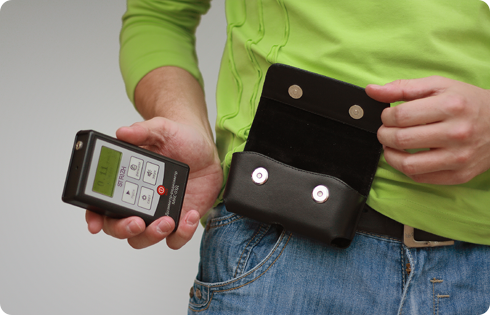
Let’s start with cheap ones. Radiation indicators, what are they good for? It’s hard to say, but if you want, you can find a lot of flattering words about them on the web. However, the following definition will not be the first to emerge: «Radiation indicators are the devices used to detect and measure the ionizing radiation with a non-regulated error». It means that you can’t really say what you’ve just measured, and how this measurement reflects the actual value.
The average ones, personal dosimeters (dosimeters-radiometers) for domestic use. The error is not strictly regulated. Regulation documents require that a mandatory reference is mentioned in the supplied documentation : «...the readings of these devices cannot be used for an official statement...»
The only dosimeter (dosimeter-radiometer) that satisfies the most stringent regulation standards is the one without the «consumer» qualifier.
So what do we choose to make a measurement? If it is not MKS-03D, then it is definitely something worthwhile, but not «consumer grade».
